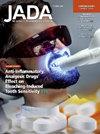A value-based care program in dentistry centered on caries risk assessment
IF 3.5
2区 医学
Q1 DENTISTRY, ORAL SURGERY & MEDICINE
引用次数: 0
Abstract
Background
The Benefits and Rewards for Utilization, Services and Healthy Outcomes program (known as BRUSH) (Liberty), a value-based oral health care program, was implemented in 4 US states from 2021 through 2022 using a caries risk assessment (CRA) strategy. This value-based care program provides oral health care for Medicaid beneficiaries up to the age of 21 years.
Methods
Deidentified data from patient insurance claims that included CRA levels with 2-year follow-up for 2,706 patients in Florida were available for analysis. Providers were incentivized to manage caries on the basis of an initial CRA and were rewarded financially if risk levels were lowered or maintained as low over 12 months. Statistical analyses were performed to identify changes in CRA over time in relation to demographic and clinical variables. Age, sex, and variables that were statistically significant in bivariate analyses were included in multiple regression models to identify predictors of change in risk level or procedures performed over the 24-month period.
Results
Results of data analysis from 2,706 patients showed that over the 24-month period, the program lowered caries risk in 64% of high-risk patients. For all risk levels at baseline, 65% had lowered risk or maintained low risk, suggesting good oral health outcomes over 24 months. Those with lowered risk were less likely to undergo restorative procedures (P < .00001).
Conclusions
A value-based dental program based on CRA can reduce or maintain caries risk at a low level for patients over a period of 2 years.
Practical Implications
A successful value-based care program improves the oral health of people through reduced caries experience and, over time, will reduce costs.
一个以龋齿风险评估为中心的基于价值的牙科护理项目
利用、服务和健康结果的收益和奖励计划(称为BRUSH) (Liberty)是一项基于价值的口腔卫生保健计划,于2021年至2022年在美国4个州实施,采用了龋齿风险评估(CRA)策略。这个基于价值的护理计划为21岁以下的医疗补助受益人提供口腔保健。方法对佛罗里达州2,706例患者进行为期2年的随访,包括CRA水平在内的患者保险索赔的确定数据进行分析。在初始CRA的基础上激励供应商管理龋齿,如果风险水平在12个月内降低或保持在较低水平,则会获得经济奖励。进行统计分析以确定CRA随时间的变化与人口统计学和临床变量的关系。年龄、性别和在双变量分析中具有统计学意义的变量被纳入多元回归模型,以确定24个月期间风险水平或手术变化的预测因素。来自2706名患者的数据分析结果显示,在24个月的时间里,该项目降低了64%的高危患者的龋齿风险。对于基线的所有风险水平,65%的人降低了风险或维持了低风险,这表明在24个月内口腔健康状况良好。风险较低的患者不太可能接受恢复性手术(P <;.00001)。结论以CRA为基础的基于价值的牙科项目可使患者的龋病风险在2年内降低或维持在较低水平。一个成功的以价值为基础的护理项目通过减少龋齿的经历来改善人们的口腔健康,并且随着时间的推移,将降低成本。
本文章由计算机程序翻译,如有差异,请以英文原文为准。
求助全文
约1分钟内获得全文
求助全文
来源期刊

Journal of the American Dental Association
医学-牙科与口腔外科
CiteScore
5.30
自引率
10.30%
发文量
221
审稿时长
34 days
期刊介绍:
There is not a single source or solution to help dentists in their quest for lifelong learning, improving dental practice, and dental well-being. JADA+, along with The Journal of the American Dental Association, is striving to do just that, bringing together practical content covering dentistry topics and procedures to help dentists—both general dentists and specialists—provide better patient care and improve oral health and well-being. This is a work in progress; as we add more content, covering more topics of interest, it will continue to expand, becoming an ever-more essential source of oral health knowledge.
 求助内容:
求助内容: 应助结果提醒方式:
应助结果提醒方式:


